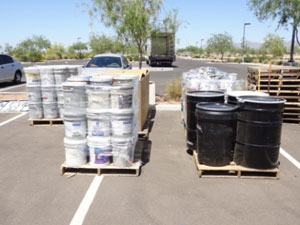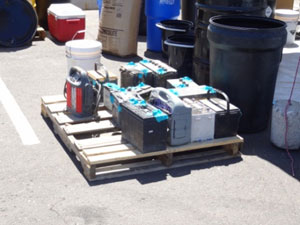Pesticide Enforcement & Hazardous Substances Program
The primary program goal for the Salt River Pima-Maricopa Indian Community (SRPMIC) CDD/EPNR Pesticide Enforcement Program/Hazardous Substances Program is to ensure pesticides are used, sold and stored according to their label. The Pesticide Enforcement Program/Hazardous Substances Program performs the following duties: 1) Pesticide Enforcement; 2) Worker Protection Standards; 3) Integrated Pest Management; 4) Education and Outreach; and 5) Hazardous Substances.
Pesticide Enforcement
The Pesticide Enforcement Program ensures compliance by conducting unannounced marketplace and maintenance yard inspections. The Pesticide Enforcement Program also monitors pesticide applications conducted by commercial, structural and agricultural pesticide applicators. These routine inspections and application monitoring are performed to ensure that pesticides are being utilized correctly, safely and according to their label for direction of use as well as in accordance with the Tribal Pesticide Ordinance. The program also assists and provides technical assistance to other Tribal Pesticide Programs within Region 9.
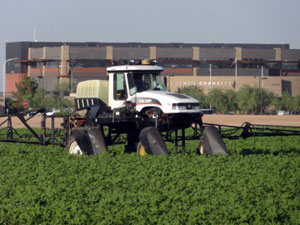
Farm machinery applying insecticide
Worker Protection Standards
The Pesticide Enforcement Program reestablished a Worker Protection Standards (WPS) Program. The main component of WPS is conducting WPS training on pesticide safety, worker protection standards, first aid, and heat stress. WPS training is conducted with field farm workers and to SRPMIC Public Works, Engineering and Construction Services employees.
Integrated Pest Management
The Pesticide Enforcement Program implemented an Integrated Pest Management (IPM) Program at all of the Community’s schools. IPM primary goal is to reduce pesticide exposure to the students, teachers, and staff who attend and work at the Community schools. The reduction of pesticide exposure by utilizing safer alternative pest control methods, such as replacing door sweeps at the sides and bottoms of doors; placing glue traps at the corners of each classroom, office and utility closet; caulking cracks and crevices located interiorly and exteriorly of each school; and placing ultra violet lights to attract pests, will aide those students who are chemically sensitive or with allergies.
The Pesticide Enforcement Program conduct pest audits at the Community schools and addresses the following pests: rodents, cockroaches, pigeons, water bugs, flies, ants and bees. The Pesticide Enforcement Program also identified possible building deficiencies, i.e. missing door sweeps on classroom doors, holes in window screens, cracks both inside and outside, etc., that require repair to prevent entry by pests. The Pesticide Enforcement Program works with the Community’s Public Works Department and school maintenance staff to assist with placement of alternative pest control methods.
Education and Outreach
The major element of the Pesticide Enforcement Program is education and outreach. The types of education and outreach performed annually are on pesticide safety (“Read the Label First”); IPM (reduction of pesticide usage and safer alternatives); biannual household hazardous waste (safe disposal of unused chemicals); and WPS (prevention of heat stress and basic first aid) . Education and outreach is conducted throughout the Community (District Council meetings, Community sponsored events, schools, etc.) and to various audiences (Elders, Community members, children, staff, etc.) on a regular basis.
Hazardous Substances
Hazardous Substances Program manages biannual household hazardous waste collection and removal. The Hazardous Substances Program coordinates with other CDD/EPNR Programs to address actual and/or potential impacts to the environment and human health. One example would be the investigation of illegal dumps with the Solid Waste Program. Currently, the Hazardous Substances Program hosts two Hazardous Waste Cleanup Days; one in October during the Fall Overhaul Event and the other in April during Earth Day. In the past, during those events, the Hazardous Substances Program collected over 20,000 pounds of hazardous waste, of which, 400 pounds were unused or used pesticides.
Resources
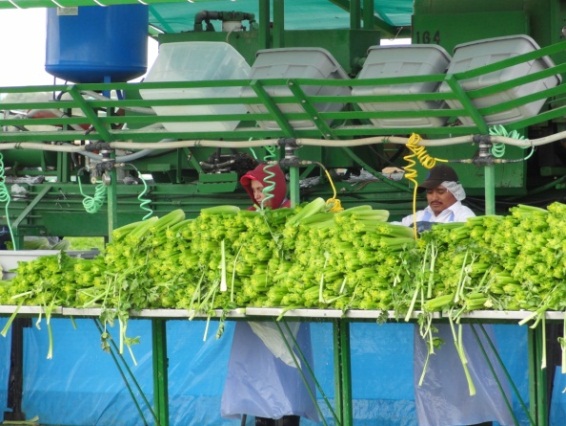
Farm field workers preparing produce for packing and shipping
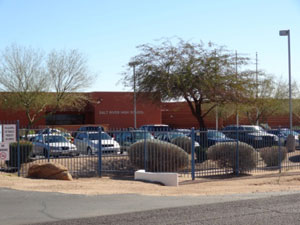
IPM at Salt River High School
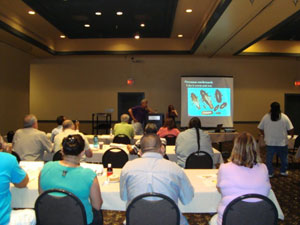
IPM training at Talking Stick Resort
- Collecting unused paint for recycling
- Collecting used batteries for recycling
